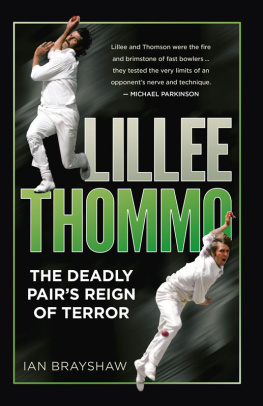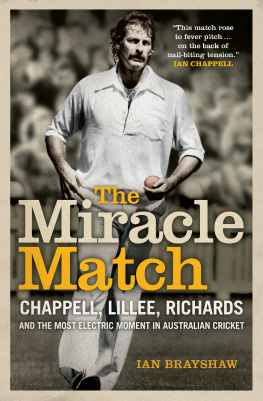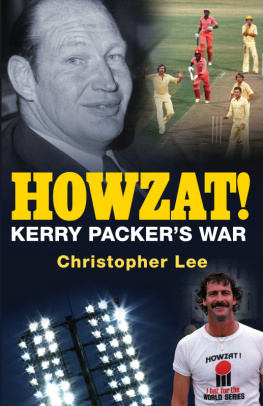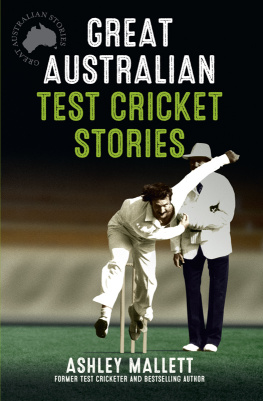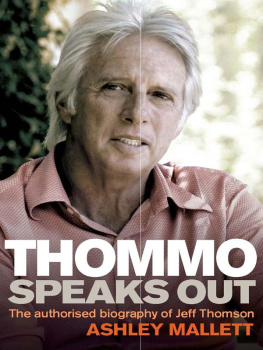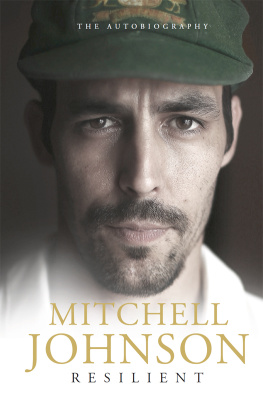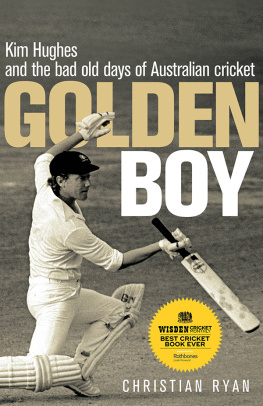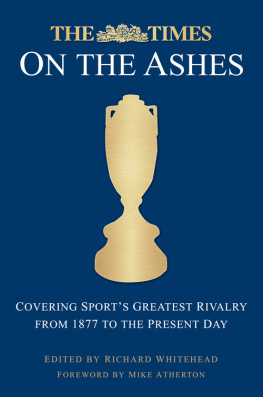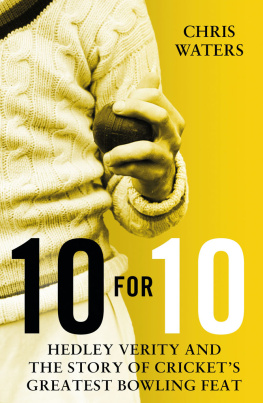Viv Richards, reflecting on his foray as a young man into boxing: Fighting was hard,but not as hard as facing Dennis Lillee and Jeff Thomson.
THE CONTRIBUTORS
In gathering material, the author was grateful to interview many players, an umpire, a longstanding cricket correspondent and the son of a legendary cricketer. Thank you to the following who contributed:
Ian Chappell Australian captain
Greg Chappell Australian captain
Geoff Howarth New Zealand captain
Mike Brearley England captain
Rod Marsh Australian wicketkeeper
Dennis Amiss England batsman
David Lloyd England batsman
John Wright New Zealand batsman
John Inverarity Australian batsman
Ross Edwards Australian batsman
Bruce Laird Australian batsman
Robin Bailhache Test umpire
John Woodcock London Times Cricket Correspondent
Jeremy Cowdrey son of Sir Colin Cowdrey
CONTENTS

Dennis Lillee, Max Walker and Jeff Thomson celebrate after Australia won the first Test match between England and Australia at Edgbaston, Birmingham, 14 July 1975. Australia won the match by an innings and 85 runs. (Photo by Ken Kelly/Popperfoto/Getty Images)
THE OLD Adelaide Oval. Flanking the western side of the ground, the rust-red iron roof of the Sir Edwin Smith, George Giffen and Mostyn Evan stands; on the eastern side, concrete terraces concealing the Victor Richardson Gates, and in between and to the north, The Hill and the famous Edwardian scoreboard. Above the lot, imperiously looking down upon the glorious scene, St Peters Cathedral.
Out in the middle, the traditionally batsman-friendly pitch is surrounded by an outfield as pure and true as the putting greens at the not-too-distant Royal Adelaide Golf Club. Adding to the grounds uniqueness and charm, the players dressing rooms: side-on to the wicket, rather than the usual end-on. This position offered resting players a sleepy view across the ground and beyond to the Adelaide Hills. For the next man in, however, it gave a distorted view of the pace of the bowling he was preparing to face; it conspired to make a fast-medium bowler look really quick!
Few more than 1000 people were present at the ground on 25 October 1974 not surprising, given it was a week day and rain clouds hung low over the flat city. Although it was just another days play in the time-honoured Sheffield Shield competition, it was a very special day in the larger context of Australian cricket. Dennis Lillee would be back in action at the head of Western Australias attack, testing the strength of his back after a season missed through injury. The rain clouds fulfilled their promise, and when the days play was eventually called off, with not one wicket fallen, Lillee returned to the dressing room, pleased to find his body intact. He sat down, already planning a more robust workout the following day.
Before being struck down by a crippling back injury, Lillee was one of the worlds premier fast bowlers. Back injuries are notoriously fickle and prognoses uncertain, so there was considerable interest in Lillees return. So much interest that his captain, John Inverarity, took an unusual step. We didnt want Dennis to be distracted, so we arranged a media conference, to be held at our motel the day before the game. The idea was to offer the media open slather so that they would leave Lillee alone once the game started. Leave him free to let his bowling do the talking.
Day two of the game dawned fine and sunny. It was a Saturday, so Adelaides boilermakers and bankers, its builders and barristers, were free to attend. The crowd swelled to 5000 more than would attend the entire four days play of other games that season. Among those at the ground that day was a very special group: the touring party of the Marleybone Cricket Club (MCC), as the English team was quaintly known in all but test matches. The very batsmen who would have to see off the fury of Lillee if his back was up to it. They had just arrived Down Under and had booked a session in the nets, which were laid out on turf behind the Mostyn Evan Stand. As Lillee warmed to the task, a group of men in whites appeared up the concrete steps that led to the grandstands from the practice area. It was the MCC players.
Dennis Amiss: I was one of the England players who left the nets in Adelaide to watch Dennis that day. He bowled off a short run and still looked a good bowler. The action was still there. We just thought, If hes going to bowl off a short run we might be able to handle that.
The man himself was aware of this special audience. I noticed that a number of the English players wandered over from the nets when I opened the bowling. I also saw that they walked away fairly swiftly, after watching only a few balls. They clearly thought this new-look Dennis Lillee was going to be no threat to them at all. In fact, Englands captain, Mike Denness, is reported as saying: He was not employing the high kick and jump, which he had used just before delivery neither did he look as quick as before.
That may have been an accurate observation from that day, but was it really a sign of what was to come? According to one of Lillees teammates, the deception, if you could call it that, had worked.
Ross Edwards: Dennis was bowling downhill at the time, not too quick because it was his first game back after injury, and you could almost see the smile on the Poms faces, because it appeared from this little cameo that he wasnt going to be a major force in our attack for the Test series. He could only bowl medium pace his back was broken da-da, da-da-da-da.
The author stood in the slips in Lillees comeback games and, along with others, found the task particularly difficult. Lillee was testing his back off a short run, which meant the slips cordon had to stand closer to the action than was the case when he was working at full tilt. That proximity to the batsman was fine until Lillee squeezed out the occasional effort ball and then those in the cordon needed the extra couple of metres distance from the batsman to get their hands in place to have any chance of making the catch.
Lillee packed his bags after that game, which his team had won by two wickets, happy that step one had been negotiated safely. There was a very warm vibe in the WA camp. Their main man had sent down a total of 28 overs, taken seven wickets and, most importantly, had emerged unscathed. In both innings he dismissed the South Australian and, more importantly, Australian captain, Ian Chappell which couldnt have done his chances of national selection any harm. On to Melbourne then. His return at the hallowed ground was 27 overs and four wickets. In Sydney he upped the workload to 45 overs for four wickets. Finally to Brisbane, 34 overs and four more wickets. All of these eight-ball overs, as was the way in those days in Australia. A fair workload for a fast bowler on the comeback trail.
That month on the road for his state side had been a serious test of Lillees back. He had sent down a total of 134 overs more than a thousand deliveries in match conditions producing 19 wickets. A wicket every seven overs.
Feeling his way back, operating mainly off a shortened run, bowling within himself. There promised to be a weeks rest, then the first Test against England in Brisbane. Would the champion make it back after a heartbreaking twenty-one months in rehabilitation?

